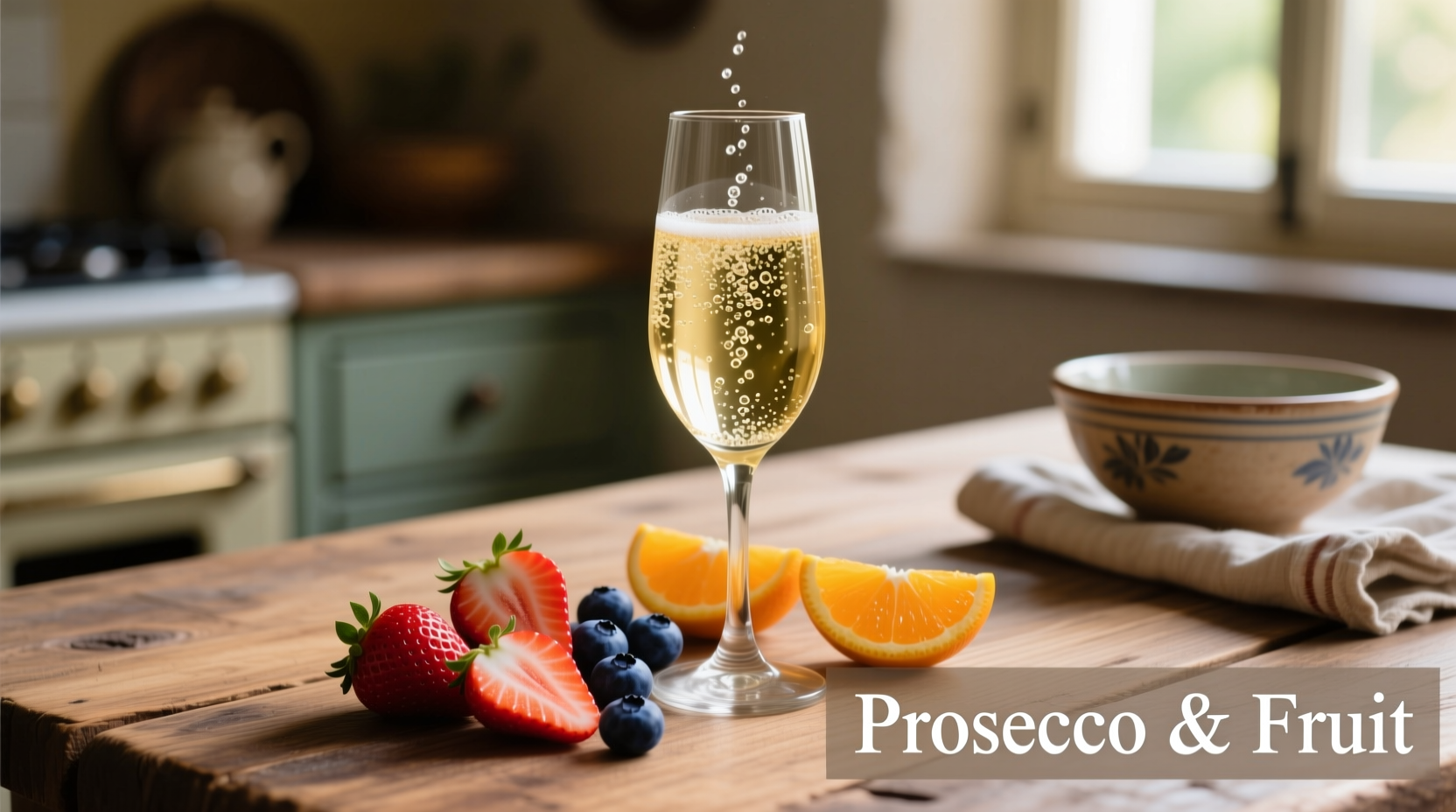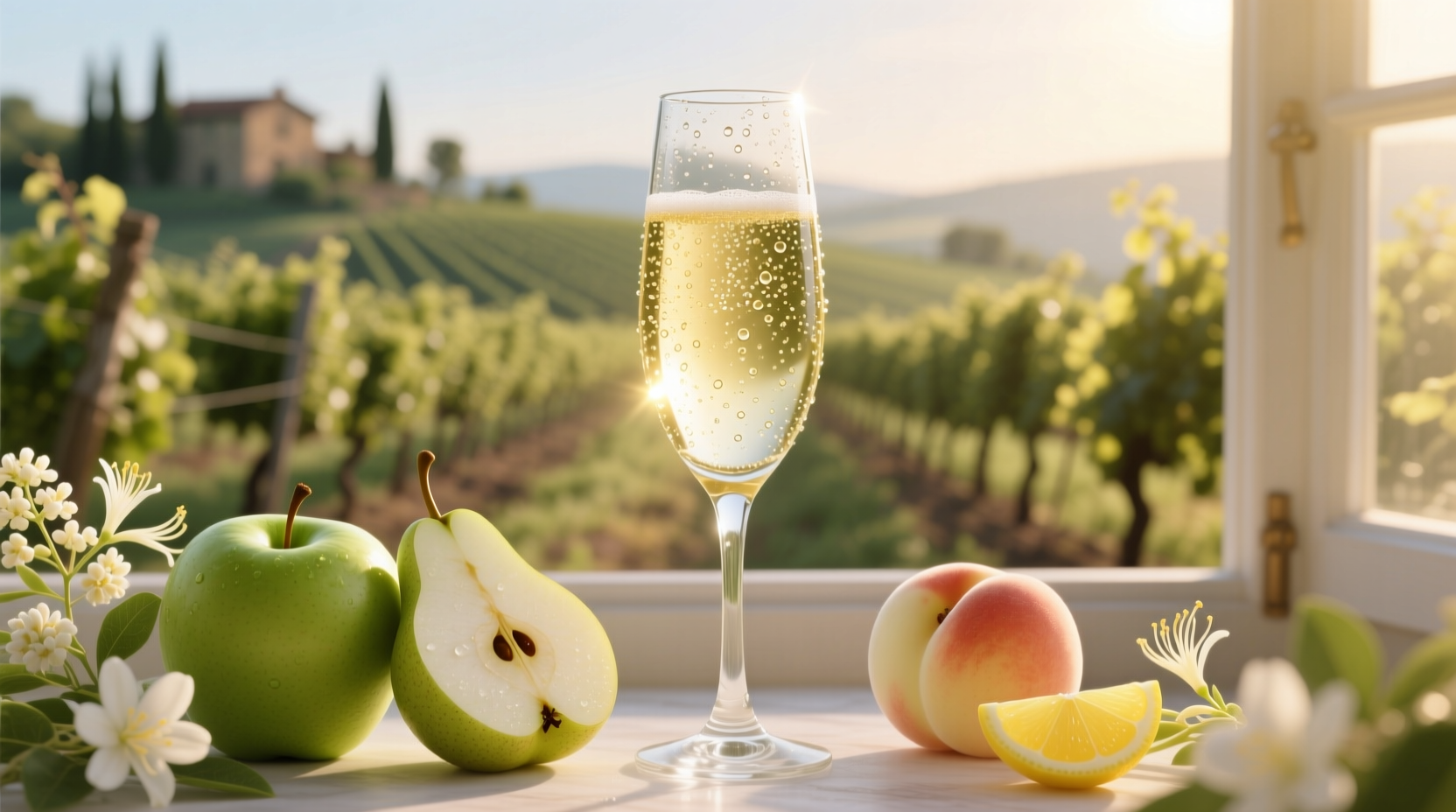Discovering Prosecco's Signature Flavor Profile
When you take your first sip of Prosecco, you'll immediately notice its vibrant, approachable character. Unlike the more complex, yeasty flavors of Champagne, Prosecco delivers a burst of fresh fruit flavors that dance across your palate. The Glera grape—which must comprise at least 85% of Prosecco—creates this distinctive profile that has made the Italian sparkling wine a global favorite.
What Exactly Does Prosecco Taste Like? A Sensory Breakdown
Understanding Prosecco's taste requires examining its complete sensory experience:
Aroma Characteristics
Bring a glass to your nose and you'll detect delicate floral notes of acacia blossom and wisteria, mingled with fresh citrus zest and green apple. Higher quality Prosecco DOCG from Conegliano-Valdobbiadene often shows more complex aromas of honeydew melon and almond blossom. The aroma should always smell clean and fresh—never yeasty or bready like traditional method sparkling wines.
Flavor Notes on the Palate
When tasting Prosecco, these primary flavor notes dominate:
- Fruit-forward profile: Green apple, pear, white peach, and citrus (particularly lemon and lime)
- Subtle floral hints: Acacia, honeysuckle, and sometimes jasmine
- Mineral undertones: Especially in hill-grown DOCG Prosecco, you might detect a delicate stony minerality
- Clean finish: Unlike Champagne, Prosecco lacks prominent brioche or toast notes
Mouthfeel and Structure
Prosecco's texture is light and refreshing with fine, persistent bubbles that feel gentle on the tongue. The acidity is moderate—bright enough to refresh but never sharp or tart. Alcohol content typically ranges from 11-12.5% ABV, contributing to its easy-drinking nature. The finish is clean and short to medium in length, making it exceptionally food-friendly.
| Sweetness Level | Residual Sugar (g/L) | Taste Profile | Best For |
|---|---|---|---|
| Brut | 0-12 | Dry, crisp, refreshing | Aperitifs, seafood, light appetizers |
| Extra Dry | 12-17 | Slightly fruity, balanced | Brunch, creamy pasta, mild cheeses |
| Dry | 17-32 | Noticeably sweet, fruit-forward | Desserts, fruit-based dishes |
How Prosecco Production Shapes Its Taste
The Charmat method (tank fermentation) is primarily responsible for Prosecco's distinctive flavor profile. Unlike Champagne's traditional method where secondary fermentation occurs in the bottle, Prosecco's secondary fermentation happens in large stainless steel tanks. This process:
- Preserves fresh fruit aromas and flavors
- Creates gentler, finer bubbles
- Maintains higher acidity levels
- Prevents development of yeasty, bready notes
According to the Consorzio Tutela Prosecco DOC, this production method is essential to maintaining Prosecco's signature freshness. The organization regulates that Prosecco must be made from at least 85% Glera grapes grown in specific regions of Northeast Italy.
Prosecco vs. Champagne: Understanding the Taste Differences
Many people wonder how Prosecco compares to Champagne. While both are sparkling wines, their taste profiles differ significantly:
| Characteristic | Prosecco | Champagne |
|---|---|---|
| Primary Grapes | Glera (min. 85%) | Chardonnay, Pinot Noir, Pinot Meunier |
| Production Method | Charmat (tank) | Traditional (in bottle) |
| Flavor Profile | Fruit-forward, floral, fresh | Yeasty, bready, complex |
| Bubble Texture | Fine, gentle, persistent | Denser, creamier |
| Best Served | Within 1-2 years of vintage | Often aged 3+ years |
When Prosecco Shines: Perfect Pairing Opportunities
Prosecco's light, crisp profile makes it exceptionally versatile for food pairings. Understanding its taste characteristics helps you match it perfectly with dishes:
Ideal Food Matches for Different Prosecco Styles
- Brut Prosecco: Seafood antipasti, grilled shrimp, light vegetable risotto, fresh goat cheese
- Extra Dry Prosecco: Brunch dishes, creamy pasta sauces, prosciutto-wrapped melon, mild blue cheeses
- Dry Prosecco: Fruit-based desserts, light pastries, spicy Asian cuisine
A 2023 study published in the Beverages journal analyzed consumer preferences and found that 78% of participants preferred Prosecco with lighter, fresher dishes compared to Champagne, which paired better with richer foods. The research confirmed Prosecco's reputation as an exceptionally food-friendly sparkling wine.
Serving Prosecco for Optimal Flavor Experience
To fully appreciate Prosecco's taste profile, proper serving temperature and glassware matter:
- Temperature: Chill to 43-48°F (6-9°C)—too cold masks flavors
- Glassware: Use tulip-shaped glasses that preserve bubbles while concentrating aromas
- Opening technique: Twist the bottle, not the cork, for a gentle release that preserves carbonation
- Timing: Enjoy within 1-2 years of vintage for peak freshness

Common Misconceptions About Prosecco's Taste
Several myths persist about Prosecco's flavor profile:
- "All Prosecco is sweet": Most Prosecco (especially Brut) is actually dry—check the label for sweetness level
- "Prosecco lacks complexity": High-quality DOCG Prosecco from Conegliano-Valdobbiadene offers remarkable complexity and terroir expression
- "Prosecco gives worse headaches": Research from the National Institutes of Health shows headache incidence is similar across sparkling wines when consumed in equal amounts
Choosing the Right Prosecco for Your Taste Preferences
With so many options available, consider these factors when selecting a Prosecco:
- Look for DOCG designation: Indicates higher quality from specific hillside regions
- Check the vintage: Non-vintage is most common, but vintage-dated Prosecco offers more complexity
- Consider the producer: Smaller, family-owned producers often make more distinctive wines
- Read between the lines: "Cartizze" indicates the most prestigious sub-zone with concentrated flavors
Remember that Prosecco's taste evolves as it opens up in the glass. Let it breathe for 2-3 minutes after pouring to experience its full aromatic potential. The initial crispness will soften slightly, revealing more nuanced fruit notes.
Final Thoughts: Embracing Prosecco's Refreshing Character
Prosecco's enduring popularity stems from its approachable, fruit-forward taste profile that delivers consistent refreshment without overwhelming complexity. Whether you're enjoying it as an aperitif, pairing it with food, or using it in creative cocktails, understanding its distinctive flavor characteristics helps you select and appreciate Prosecco that perfectly matches your preferences. The next time you pour a glass, take a moment to identify those signature green apple and pear notes with their delicate floral undertones—that's the essence of authentic Prosecco taste.
Frequently Asked Questions
Is Prosecco sweeter than Champagne?
Most Prosecco (labeled Brut) is actually drier than many Champagnes. Prosecco's fruit-forward profile can create a perception of sweetness, but Brut Prosecco contains 0-12g/L residual sugar compared to many Champagnes that range from 6-12g/L. Extra Dry Prosecco (12-17g/L) has slightly more sugar but still falls within the dry category.
Why does my Prosecco taste different from bottle to bottle?
Prosecco's taste varies based on production region (DOC vs DOCG), specific vineyard location, harvest conditions, and producer techniques. DOCG Prosecco from Conegliano-Valdobbiadene typically shows more complexity and structure than DOC Prosecco from broader regions. Vintage variations also affect flavor intensity and fruit profile.
Does Prosecco taste like regular white wine?
No, Prosecco has a distinctive sparkling wine profile with fine bubbles, moderate acidity, and specific fruit notes (green apple, pear, white peach) that differ from still white wines. The carbonation creates a different mouthfeel and enhances the perception of freshness. Prosecco's production method preserves primary fruit aromas rather than developing the complex secondary notes found in many still wines.
How long does Prosecco maintain its flavor after opening?
Prosecco begins losing its characteristic bubbles and freshness within 12-24 hours after opening, even with a proper stopper. Unlike Champagne, Prosecco's lighter structure means it doesn't age well once opened. For best flavor, consume within 6-12 hours after opening and store in the refrigerator with a specialized sparkling wine stopper.
Why does some Prosecco taste more floral than others?
The floral intensity in Prosecco depends on several factors: vineyard location (hillside vs valley), harvest timing, and production techniques. DOCG Prosecco from higher elevations often shows more pronounced floral notes like acacia and wisteria. The Charmat method preserves these delicate aromas better than traditional method sparkling wines. Some producers also use specific yeast strains that enhance floral characteristics during fermentation.











 浙公网安备
33010002000092号
浙公网安备
33010002000092号 浙B2-20120091-4
浙B2-20120091-4